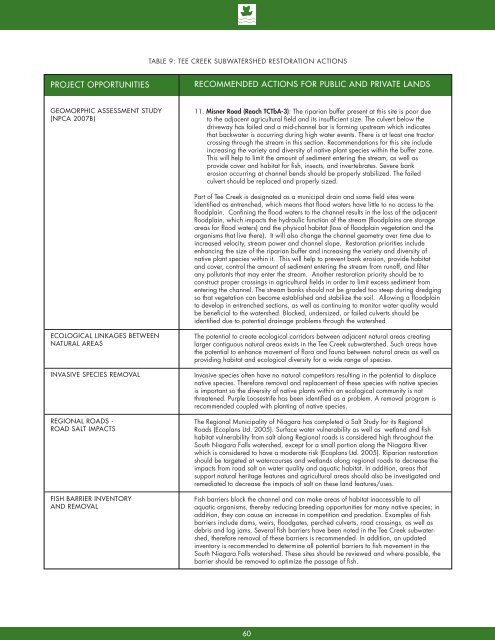8132 - NPCA SNF Watershed Report.indd - Niagara Peninsula ...
8132 - NPCA SNF Watershed Report.indd - Niagara Peninsula ...
8132 - NPCA SNF Watershed Report.indd - Niagara Peninsula ...
Create successful ePaper yourself
Turn your PDF publications into a flip-book with our unique Google optimized e-Paper software.
table 9: tee creek subwatershed restoration actionsPROJECT OPPORTUNITIESRECOMMENDED ACTIONS FOR PUBLIC AND PRIVATE LANDSGEOMORPHIC ASSESSMENT STUDY(<strong>NPCA</strong> 2007B)11. Misner Road (Reach TCTbA-3): The riparian buffer present at this site is poor dueto the adjacent agricultural field and its insufficient size. The culvert below thedriveway has failed and a mid-channel bar is forming upstream which indicatesthat backwater is occurring during high water events. There is at least one tractorcrossing through the stream in this section. Recommendations for this site includeincreasing the variety and diversity of native plant species within the buffer zone.This will help to limit the amount of sediment entering the stream, as well asprovide cover and habitat for fish, insects, and invertebrates. Severe bankerosion occurring at channel bends should be properly stabilized. The failedculvert should be replaced and properly sized.Part of Tee Creek is designated as a municipal drain and some field sites wereidentified as entrenched, which means that flood waters have little to no access to thefloodplain. Confining the flood waters to the channel results in the loss of the adjacentfloodplain, which impacts the hydraulic function of the stream (floodplains are storageareas for flood waters) and the physical habitat (loss of floodplain vegetation and theorganisms that live there). It will also change the channel geometry over time due toincreased velocity, stream power and channel slope. Restoration priorities includeenhancing the size of the riparian buffer and increasing the variety and diversity ofnative plant species within it. This will help to prevent bank erosion, provide habitatand cover, control the amount of sediment entering the stream from runoff, and filterany pollutants that may enter the stream. Another restoration priority should be toconstruct proper crossings in agricultural fields in order to limit excess sediment fromentering the channel. The stream banks should not be graded too steep during dredgingso that vegetation can become established and stabilize the soil. Allowing a floodplainto develop in entrenched sections, as well as continuing to monitor water quality wouldbe beneficial to the watershed. Blocked, undersized, or failed culverts should beidentified due to potential drainage problems through the watershedECOLOGICAL LINKAGES BETWEENNATURAL AREASINVASIVE SPECIES REMOVALREGIONAL ROADS -ROAD SALT IMPACTSFISH BARRIER INVENTORYAND REMOVALThe potential to create ecological corridors between adjacent natural areas creatinglarger contiguous natural areas exists in the Tee Creek subwatershed. Such areas havethe potential to enhance movement of flora and fauna between natural areas as well asproviding habitat and ecological diversity for a wide range of species.Invasive species often have no natural competitors resulting in the potential to displacenative species. Therefore removal and replacement of these species with native speciesis important so the diversity of native plants within an ecological community is notthreatened. Purple Loosestrife has been identified as a problem. A removal program isrecommended coupled with planting of native species.The Regional Municipality of <strong>Niagara</strong> has completed a Salt Study for its RegionalRoads (Ecoplans Ltd. 2005). Surface water vulnerability as well as wetland and fishhabitat vulnerability from salt along Regional roads is considered high throughout theSouth <strong>Niagara</strong> Falls watershed, except for a small portion along the <strong>Niagara</strong> Riverwhich is considered to have a moderate risk (Ecoplans Ltd. 2005). Riparian restorationshould be targeted at watercourses and wetlands along regional roads to decrease theimpacts from road salt on water quality and aquatic habitat. In addition, areas thatsupport natural heritage features and agricultural areas should also be investigated andremediated to decrease the impacts of salt on these land features/uses.Fish barriers block the channel and can make areas of habitat inaccessible to allaquatic organisms, thereby reducing breeding opportunities for many native species; inaddition, they can cause an increase in competition and predation. Examples of fishbarriers include dams, weirs, floodgates, perched culverts, road crossings, as well asdebris and log jams. Several fish barriers have been noted in the Tee Creek subwatershed,therefore removal of these barriers is recommended. In addition, an updatedinventory is recommended to determine all potential barriers to fish movement in theSouth <strong>Niagara</strong> Falls watershed. These sites should be reviewed and where possible, thebarrier should be removed to optimize the passage of fish.60
















